Xu Zhang
BoRe-Depth: Self-supervised Monocular Depth Estimation with Boundary Refinement for Embedded Systems
Nov 06, 2025Abstract:Depth estimation is one of the key technologies for realizing 3D perception in unmanned systems. Monocular depth estimation has been widely researched because of its low-cost advantage, but the existing methods face the challenges of poor depth estimation performance and blurred object boundaries on embedded systems. In this paper, we propose a novel monocular depth estimation model, BoRe-Depth, which contains only 8.7M parameters. It can accurately estimate depth maps on embedded systems and significantly improves boundary quality. Firstly, we design an Enhanced Feature Adaptive Fusion Module (EFAF) which adaptively fuses depth features to enhance boundary detail representation. Secondly, we integrate semantic knowledge into the encoder to improve the object recognition and boundary perception capabilities. Finally, BoRe-Depth is deployed on NVIDIA Jetson Orin, and runs efficiently at 50.7 FPS. We demonstrate that the proposed model significantly outperforms previous lightweight models on multiple challenging datasets, and we provide detailed ablation studies for the proposed methods. The code is available at https://github.com/liangxiansheng093/BoRe-Depth.
Traceable Drug Recommendation over Medical Knowledge Graphs
Oct 31, 2025



Abstract:Drug recommendation (DR) systems aim to support healthcare professionals in selecting appropriate medications based on patients' medical conditions. State-of-the-art approaches utilize deep learning techniques for improving DR, but fall short in providing any insights on the derivation process of recommendations -- a critical limitation in such high-stake applications. We propose TraceDR, a novel DR system operating over a medical knowledge graph (MKG), which ensures access to large-scale and high-quality information. TraceDR simultaneously predicts drug recommendations and related evidence within a multi-task learning framework, enabling traceability of medication recommendations. For covering a more diverse set of diseases and drugs than existing works, we devise a framework for automatically constructing patient health records and release DrugRec, a new large-scale testbed for DR.
Moving Beyond Diffusion: Hierarchy-to-Hierarchy Autoregression for fMRI-to-Image Reconstruction
Oct 25, 2025Abstract:Reconstructing visual stimuli from fMRI signals is a central challenge bridging machine learning and neuroscience. Recent diffusion-based methods typically map fMRI activity to a single high-level embedding, using it as fixed guidance throughout the entire generation process. However, this fixed guidance collapses hierarchical neural information and is misaligned with the stage-dependent demands of image reconstruction. In response, we propose MindHier, a coarse-to-fine fMRI-to-image reconstruction framework built on scale-wise autoregressive modeling. MindHier introduces three components: a Hierarchical fMRI Encoder to extract multi-level neural embeddings, a Hierarchy-to-Hierarchy Alignment scheme to enforce layer-wise correspondence with CLIP features, and a Scale-Aware Coarse-to-Fine Neural Guidance strategy to inject these embeddings into autoregression at matching scales. These designs make MindHier an efficient and cognitively-aligned alternative to diffusion-based methods by enabling a hierarchical reconstruction process that synthesizes global semantics before refining local details, akin to human visual perception. Extensive experiments on the NSD dataset show that MindHier achieves superior semantic fidelity, 4.67x faster inference, and more deterministic results than the diffusion-based baselines.
HAD: HAllucination Detection Language Models Based on a Comprehensive Hallucination Taxonomy
Oct 22, 2025Abstract:The increasing reliance on natural language generation (NLG) models, particularly large language models, has raised concerns about the reliability and accuracy of their outputs. A key challenge is hallucination, where models produce plausible but incorrect information. As a result, hallucination detection has become a critical task. In this work, we introduce a comprehensive hallucination taxonomy with 11 categories across various NLG tasks and propose the HAllucination Detection (HAD) models https://github.com/pku0xff/HAD, which integrate hallucination detection, span-level identification, and correction into a single inference process. Trained on an elaborate synthetic dataset of about 90K samples, our HAD models are versatile and can be applied to various NLG tasks. We also carefully annotate a test set for hallucination detection, called HADTest, which contains 2,248 samples. Evaluations on in-domain and out-of-domain test sets show that our HAD models generally outperform the existing baselines, achieving state-of-the-art results on HaluEval, FactCHD, and FaithBench, confirming their robustness and versatility.
GeoPurify: A Data-Efficient Geometric Distillation Framework for Open-Vocabulary 3D Segmentation
Oct 02, 2025



Abstract:Recent attempts to transfer features from 2D Vision-Language Models (VLMs) to 3D semantic segmentation expose a persistent trade-off. Directly projecting 2D features into 3D yields noisy and fragmented predictions, whereas enforcing geometric coherence necessitates costly training pipelines and large-scale annotated 3D data. We argue that this limitation stems from the dominant segmentation-and-matching paradigm, which fails to reconcile 2D semantics with 3D geometric structure. The geometric cues are not eliminated during the 2D-to-3D transfer but remain latent within the noisy and view-aggregated features. To exploit this property, we propose GeoPurify that applies a small Student Affinity Network to purify 2D VLM-generated 3D point features using geometric priors distilled from a 3D self-supervised teacher model. During inference, we devise a Geometry-Guided Pooling module to further denoise the point cloud and ensure the semantic and structural consistency. Benefiting from latent geometric information and the learned affinity network, GeoPurify effectively mitigates the trade-off and achieves superior data efficiency. Extensive experiments on major 3D benchmarks demonstrate that GeoPurify achieves or surpasses state-of-the-art performance while utilizing only about 1.5% of the training data. Our codes and checkpoints are available at [https://github.com/tj12323/GeoPurify](https://github.com/tj12323/GeoPurify).
SimCroP: Radiograph Representation Learning with Similarity-driven Cross-granularity Pre-training
Sep 10, 2025Abstract:Medical vision-language pre-training shows great potential in learning representative features from massive paired radiographs and reports. However, in computed tomography (CT) scans, the distribution of lesions which contain intricate structures is characterized by spatial sparsity. Besides, the complex and implicit relationships between different pathological descriptions in each sentence of the report and their corresponding sub-regions in radiographs pose additional challenges. In this paper, we propose a Similarity-Driven Cross-Granularity Pre-training (SimCroP) framework on chest CTs, which combines similarity-driven alignment and cross-granularity fusion to improve radiograph interpretation. We first leverage multi-modal masked modeling to optimize the encoder for understanding precise low-level semantics from radiographs. Then, similarity-driven alignment is designed to pre-train the encoder to adaptively select and align the correct patches corresponding to each sentence in reports. The cross-granularity fusion module integrates multimodal information across instance level and word-patch level, which helps the model better capture key pathology structures in sparse radiographs, resulting in improved performance for multi-scale downstream tasks. SimCroP is pre-trained on a large-scale paired CT-reports dataset and validated on image classification and segmentation tasks across five public datasets. Experimental results demonstrate that SimCroP outperforms both cutting-edge medical self-supervised learning methods and medical vision-language pre-training methods. Codes and models are available at https://github.com/ToniChopp/SimCroP.
Incorporating Legal Logic into Deep Learning: An Intelligent Approach to Probation Prediction
Aug 17, 2025Abstract:Probation is a crucial institution in modern criminal law, embodying the principles of fairness and justice while contributing to the harmonious development of society. Despite its importance, the current Intelligent Judicial Assistant System (IJAS) lacks dedicated methods for probation prediction, and research on the underlying factors influencing probation eligibility remains limited. In addition, probation eligibility requires a comprehensive analysis of both criminal circumstances and remorse. Much of the existing research in IJAS relies primarily on data-driven methodologies, which often overlooks the legal logic underpinning judicial decision-making. To address this gap, we propose a novel approach that integrates legal logic into deep learning models for probation prediction, implemented in three distinct stages. First, we construct a specialized probation dataset that includes fact descriptions and probation legal elements (PLEs). Second, we design a distinct probation prediction model named the Multi-Task Dual-Theory Probation Prediction Model (MT-DT), which is grounded in the legal logic of probation and the \textit{Dual-Track Theory of Punishment}. Finally, our experiments on the probation dataset demonstrate that the MT-DT model outperforms baseline models, and an analysis of the underlying legal logic further validates the effectiveness of the proposed approach.
Perception-Oriented Latent Coding for High-Performance Compressed Domain Semantic Inference
Jul 02, 2025Abstract:In recent years, compressed domain semantic inference has primarily relied on learned image coding models optimized for mean squared error (MSE). However, MSE-oriented optimization tends to yield latent spaces with limited semantic richness, which hinders effective semantic inference in downstream tasks. Moreover, achieving high performance with these models often requires fine-tuning the entire vision model, which is computationally intensive, especially for large models. To address these problems, we introduce Perception-Oriented Latent Coding (POLC), an approach that enriches the semantic content of latent features for high-performance compressed domain semantic inference. With the semantically rich latent space, POLC requires only a plug-and-play adapter for fine-tuning, significantly reducing the parameter count compared to previous MSE-oriented methods. Experimental results demonstrate that POLC achieves rate-perception performance comparable to state-of-the-art generative image coding methods while markedly enhancing performance in vision tasks, with minimal fine-tuning overhead. Code is available at https://github.com/NJUVISION/POLC.
PoseGRAF: Geometric-Reinforced Adaptive Fusion for Monocular 3D Human Pose Estimation
Jun 17, 2025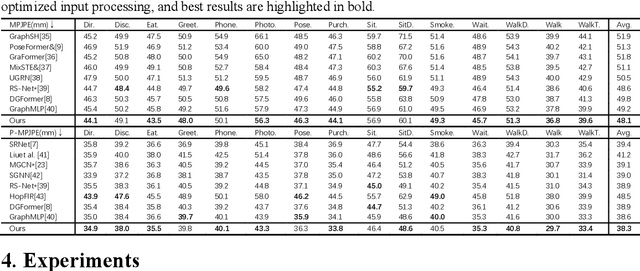

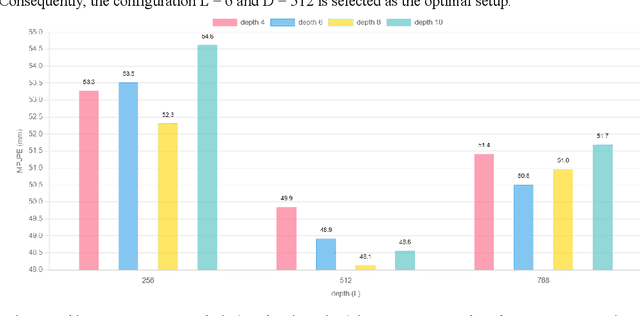
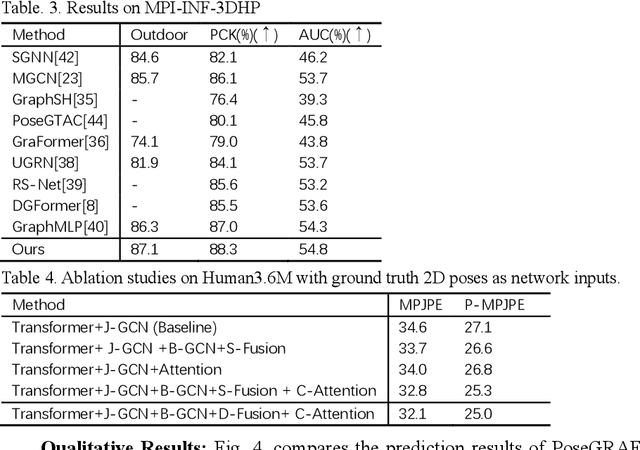
Abstract:Existing monocular 3D pose estimation methods primarily rely on joint positional features, while overlooking intrinsic directional and angular correlations within the skeleton. As a result, they often produce implausible poses under joint occlusions or rapid motion changes. To address these challenges, we propose the PoseGRAF framework. We first construct a dual graph convolutional structure that separately processes joint and bone graphs, effectively capturing their local dependencies. A Cross-Attention module is then introduced to model interdependencies between bone directions and joint features. Building upon this, a dynamic fusion module is designed to adaptively integrate both feature types by leveraging the relational dependencies between joints and bones. An improved Transformer encoder is further incorporated in a residual manner to generate the final output. Experimental results on the Human3.6M and MPI-INF-3DHP datasets show that our method exceeds state-of-the-art approaches. Additional evaluations on in-the-wild videos further validate its generalizability. The code is publicly available at https://github.com/iCityLab/PoseGRAF.
A General Knowledge Injection Framework for ICD Coding
May 24, 2025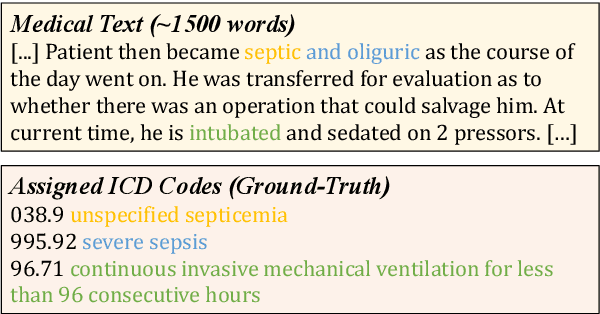

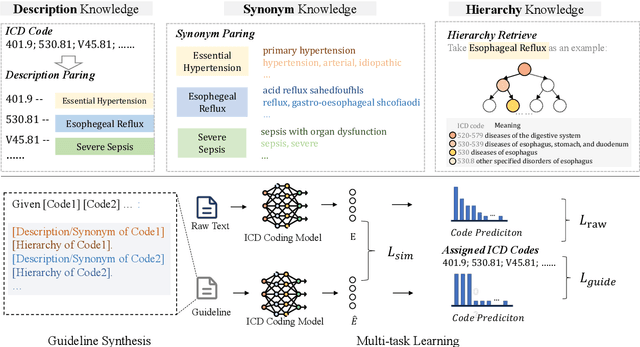

Abstract:ICD Coding aims to assign a wide range of medical codes to a medical text document, which is a popular and challenging task in the healthcare domain. To alleviate the problems of long-tail distribution and the lack of annotations of code-specific evidence, many previous works have proposed incorporating code knowledge to improve coding performance. However, existing methods often focus on a single type of knowledge and design specialized modules that are complex and incompatible with each other, thereby limiting their scalability and effectiveness. To address this issue, we propose GKI-ICD, a novel, general knowledge injection framework that integrates three key types of knowledge, namely ICD Description, ICD Synonym, and ICD Hierarchy, without specialized design of additional modules. The comprehensive utilization of the above knowledge, which exhibits both differences and complementarity, can effectively enhance the ICD coding performance. Extensive experiments on existing popular ICD coding benchmarks demonstrate the effectiveness of GKI-ICD, which achieves the state-of-the-art performance on most evaluation metrics. Code is available at https://github.com/xuzhang0112/GKI-ICD.
 Add to Chrome
Add to Chrome Add to Firefox
Add to Firefox Add to Edge
Add to Edge